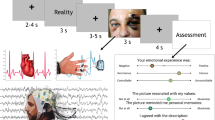Abstract
The EEG power in the β1, β2, and γ frequency bands during reading according to the method of “self-regulatory utterance” was compared in subjects reading aloud emotionally neutral business texts related to an unknown field of activity, fiction texts with clear positive or negative valences or personally important autobiographic texts with similar emotional valences. Two groups of subjects participated in the study: students training to be actors (N = 22) and students with other specializations (N = 23). We observed higher values of the EEG power in the γ (30–40 Hz) and β2 (18.5–29.5 Hz) frequency bands when comparing the states during reading of emotionally positive and emotionally negative fiction texts and personally important texts. These data are similar to our previous studies with the use of techniques that apply internal induction of positive or negative emotions without speech, in different groups of subjects. Internal induction of positive emotions was associated with an increase in the EEG power in these bands compared to the performance of an emotionally neutral task, whereas induction of negative emotions resulted in a decrease in the EEG power.
Similar content being viewed by others
References
Danko, S.G., Bechtereva, N.P., Shemyakina, N.V., and Antonova, L.V., Electroencephalographic Correlates of Mental Performance of Emotional Personal and Scenic Situations: I. Characteristics of Local Synchronization, Fiziol. Chel., 2003, vol. 29, no. 3, p. 5 [Human Physiol. (Engl. Transl.), vol. 29, no. 3, p. 263].
Danko, S.G., Bechtereva, N.P., Shemyakina, N.V., and Antonova, L.V., Electroencephalographic Correlates of Mental Performance of Emotional Autobiographic and Scenic Situations: II. Characteristics of Spatial Synchronization, Fiziol. Chel., 2003, vol. 29, no. 6, p. 1 [Human Physiol. (Engl. Transl.), vol. 29, no. 6, p. 685].
Danko, S.G., Bechtereva, N.P., Antonova, L.V., and Shemyakina, N.V., Effect of the Personality Component on the Electroencephalographic Correlates of Induced Emotional States, Fiziol. Chel., 2004, vol. 30, no. 6, p. 53 [Human Physiol. (Engl. Transl.), vol. 30, no. 6, p. 729].
Shemyakina, N.V. and Danko, S.G., Influence of the Emotional Perception of a Signal on the Electroencephalographic Correlates of Creative Activity, Fiziol. Chel., 2004, vol. 30, no. 2, p. 22 [Human Physiol. (Engl. Transl.), vol. 30, no. 2, p. 145].
Danko, S.G., The States of Human Cerebral Cortex during Internal Induction of Emotions, in Kognitivnye issledovaniya: Sbornik nauchnykh trudov (Cognitive Studies: Collection of Articles), Solov’eva, V.D. and Chernigovskaya, T.V., Eds., Moscow: Institut Psikhologii RAN, 2008, vol. 2.
Rusalova, M.N. and Kostyunina, M.B., Frequency and Amplitude Characteristics of the Left and Right Hemispheres in Subjects Experiencing Imaginary Emotions, Fiziol. Chel., 1999, vol. 25, no. 5, p. 50 [Human Physiol. (Engl. Transl.), vol. 25, no. 5, p. 543].
Pardo, J.V., Pardo, P.J., and Raichle, M.E., Neural Correlates of Self-Induced Dysphoria, Am. J. Psychiatry, 1993, vol. 150, no. 5, p. 713.
Damasio, A.R., Grabowski, T.J., Bechara, A., et al., Subcortical and Cortical Brain Activity during the Feeling of Self-Generated Emotions, Nat. Neurosci., 2000, vol. 3, no. 10, p. 1049.
Gracheva, L.V., Akterskii trening: teoriya i praktika (Actor Traning: Theory and Practice), St. Petersburg: Rech’, 2003.
Gracheva, L.V., Emotsional’nyi trening: iskusstvo vlastvovat’ soboi (Emotional Training: the Art to Dominate Itself), St. Petersburg: Rech’, 2004.
Whitham, E.M., Lewis, T., Pope, K.J., et al., Thinking Activates EMG in Scalp Electrical Recordings, Clin. Neurophysiol., 2008, vol. 119, no. 5, p. 1166.
Author information
Authors and Affiliations
Additional information
Original Russian Text © S.G. Danko, L.V. Gracheva, Yu.A. Boytsova, M.L. Solovjeva, 2011, published in Fiziologiya Cheloveka, 2011, Vol. 37, No. 5, pp. 46–50.
Rights and permissions
About this article
Cite this article
Danko, S.G., Gracheva, L.V., Boytsova, Y.A. et al. Induction of emotional states by reading aloud texts with various emotional valences and changes in the EEG power in the β and γ frequency bands. Hum Physiol 37, 555–558 (2011). https://doi.org/10.1134/S0362119711040062
Received:
Published:
Issue Date:
DOI: https://doi.org/10.1134/S0362119711040062




